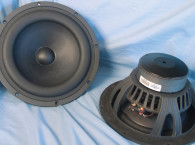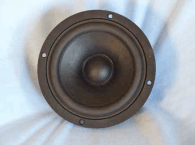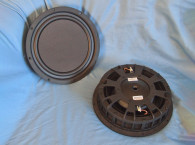
In 1990 Vifa appointed Allan Isaksen as their director of sales and engineering with responsibility for all marketing, sales, and engineering activities. In 1999 Allan Isaksen relocated from Denmark to the GuangDong Province of China, where he established the Chinese production base for Vifa/Scan-Speak, Vifa Loudspeakers (PanYu) Ltd. After Vifa and Peerless merged into DST (Danish Sound Technology), the China production company was renamed DST Loudspeakers (PanYu) Ltd., which Allan Isaksen led as general manager until he founded Wavecor Ltd in 2005.
Per Madsen also started his career at Vifa A/S Denmark in 1988 as a technical trainee, and after his graduation in 1991 he was employed as R&D engineer at Vifa A/S, where his area of responsibility was mechanical driver parts. Later he continued working on the acoustics of drivers as well and designed some of the more popular drivers at Vifa/Scan-Speak A/S through the years. In 2002 Per Madsen transferred to DST’s production facility in China, DST Loudspeakers (PanYu) Ltd., for a position as engineering manager. After DST was taken over by Tymphany (USA), Per Madsen continued working there as engineering services group manager until he decided to join Wavecor Ltd. as director of technology in 2006.


This month’s offering from Wavecor is a 4.75” paper cone midbass woofer, the WF120BD04 (Photo 1). Like the SW182, the highlight of this design is the Wavecor Balanced Drive system, a proprietary distortion reducing motor technology. Basically, Wavecor’s Balanced Drive Technology takes the form of a tapered extended pole as seen in the FEA diagram in Fig. 1. This FEA of the Balance Drive line motor design shows the dual tapered outlets on the pole vent, used to decrease turbulence in the vent. Figure 2 compares a typically standard motor with the tapered extended pole used by Wavecor. According to Wavecor this results in a more symmetrical Bl curve.
In terms of features, the WF120 is built on a six-spoke cast aluminum frame that sports a completely open area below the spider mounting shelf for enhanced cooling. The WF120 cone assembly includes a very stiff curvilinear black-coated semi-air-dried cone with a 1.13” diameter convex black-coated paper dust cap. These are suspended by a NBR butyl rubber surround that has a nice shallow angle where it attaches to the cone edge and a 3” diameter black conex flat spider.
Driving the assembly is a 26mm (1”) diameter voice coil using round copper wire wound on a black non-conducting fiberglass voice coil former that incorporates a series of eight 4mm diameter former vents just below the neck joint. The motor itself uses a single 17mm x 89mm ferrite magnet sandwiched between a shaped T-yoke and 4mm high front plate, both with a black emissive coating for enhanced cooling performance. The motor also incorporates an aluminum faraday shield/shorting ring as well as a copper cap on the top of the pole piece for distortion reduction. Voice coil tinsel lead wires are terminated to a set of gold-plated terminals.


I commenced analysis of the WF120BD04 midbass woofer using the LinearX LMS analyzer and VIBox to produce both voltage and admittance (current) curves with the driver clamped to a rigid test fixture in free-air at 0.3V, 1V, 3V, 6V, and 10V. As has become the protocol for Test Bench testing, I no longer use a single added mass measurement and instead used actual measured mass, but the manufacturer’s measured Mmd data. With most 4-5” woofers, the 10V curves turn out so nonlinear that I end up discarding them, but not so with the WF120 which remained perfectly linear out to 10V in free-air.
Next, I post-processed the ten 550-point stepped sine wave sweeps for each WF120 sample and divided the voltage curves by the current curves (admittance) to derive impedance curves, phase added by the LMS calculation method, and along with the accompanying voltage curves, imported to the LEAP 5 Enclosure Shop software. Because most Thiele/Small data provided by OEM manufacturers is being produced using either a standard method or the LEAP 4 TSL model, I additionally produced a LEAP 4 TSL model using the 1V free-air curves. I selected the complete data set, the multiple voltage impedance curves for the LTD model (see Fig. 3 for the 1V free-air impedance curve) and the 1V impedance curve for the TSL model in the transducer derivation menu in LEAP 5, and produced the parameters for the computer box simulations. Table 1 compares the LEAP 5 LTD and TSL data and factory parameters for both WF120BD04 samples.
LEAP parameter Qts calculation results for the WF120 were close to the factory data, except for the Fs. Note that Wavecor provides two parameter sets, one made without break-in and one made with substantial break-in. My data is made after a physical break-in accomplished by mechanically moving the cone assembly to the hard limits of its travel seven or eight times, enough to give the initial stretch provided by typical break-in protocols, so the Wavecor factory data is their “after burn in” data.



As is normal for these reviews, I followed my usual protocol and proceeded setting up computer enclosure simulations using the LEAP LTD parameters for Sample 1. Two computer box simulations were programmed into LEAP, one sealed and one vented. This resulted in a 0.07ft3 sealed enclosure with 50% fiberglass fill material, and a 0.12ft3 vented Chebychev/Butterworth alignment enclosure simulation with 15% fiberglass fill material and tuned to 58Hz.
Figure 4 displays the results for the WF120BD04 in the sealed and vented boxes at 2.83V and at a voltage level high enough to increase cone excursion to Xmax + 15% (4.6mm). This produced a F3 frequency of 99.7Hz with a box/driver Qtc of 0.69 for the 0.07ft3 sealed enclosure and –3dB = 70Hz for the 0.12ft3 vented simulation. Increasing the voltage input to the simulations until the maximum linear cone excursion was reached resulted in 101dB at 17V for the sealed enclosure simulation and 112.5dB with a 17V input level for the larger ported enclosure (see Figs. 5 and 6 for the 2.83V group delay curves and the 17V excursion curves).




Klippel analysis for the Wavecor 4.75” woofer produced the Bl(X), Kms(X) and Bl and Kms symmetry range plots given in Figs. 7-10. The Bl(X) curve for the WF120 (Fig. 7) is relatively broad and symmetrical, especially for a 4.75” diameter driver, and obviously also with “tilt” that includes a small forward (coil-out) offset. Looking at the Bl symmetry plot (Fig. 8), this curve shows a 0.8mm coil forward offset at the rest position that decreases to 0mm at the physical 4mm Xmax of the driver. Figures 9 and 10 show the Kms(X) and Kms symmetry range curves for the Wavecor midbass woofer.
The Kms(X) curve definitely has some asymmetry, and also with a minor rearward (coil-in) offset of about 0.8mm at the rest position that decreases to 0.25mm at the 4mm Xmax location on the graph, and increasing somewhat out to 6mm or so. While these numbers are small, it does limit the distortion levels somewhat. Displacement limiting numbers calculated by the Klippel analyzer were XBl at 82% Bl greater than 4.3mm and for XC at 75% Cms minimum was 2.3mm, which means that for this Wavecor woofer, the compliance is the most limiting factor for prescribed distortion level of 10%. This isn’t that much of an issue, especially because this woofer could easily find itself working as a midrange in a three-way product.




Figure 11 gives the inductance curve Le(X) for the WF120BD04. Inductance will typically increase in the rear direction from the zero rest position as the voice coil covers more pole area; however, the WF120 inductance stays mostly constant as the coil moves in due to the dual shorting ring configuration. The inductance variation is only 0.05mH from the in and out Xmax positions, which is very good.
Next I mounted the WF120 woofer in an enclosure which had a 14” x 5” baffle and was filled with damping material (foam) and then measured the DUT on- and off-axis from 300Hz to 40kHz frequency response at 2.83V/1m using the LinearX LMS analyzer set to a 100-point gated sine wave sweep. Figure 12 gives the on-axis response indicating a smoothly rising response to about 9kHz, rising 6dB at 1Hz mostly anomaly free to the low-pass rolloff. Figure 13 displays the on- and off-axis frequency response at 0, 15, 30, and 45º. -3dB at 30º off-axis with respect to the on-axis curve occurs at 4kHz, the recommended maximum crossover frequency by Wavecor. And finally, Fig. 14 gives the two-sample SPL comparisons for the 4.75” Wavecor driver, showing a close match to within 0.5dB throughout the operating range (excluding a small 1dB differential centered on 1.1kHz).



For the remaining battery of tests, I employed the Listen Inc. SoundCheck analyzer, ¼” SCM microphone and power supply (courtesy of Listen Inc.) to measure distortion and generate time frequency plots. For the distortion measurement, the Wavecor woofer was mounted rigidly in free air, and the SPL set to 94dB at 1m (10.6V) using a noise stimulus, and then the distortion measured with the Listen Inc. microphone placed 10cm from the dust cap. This produced the distortion curves shown in Fig. 15. I then used SoundCheck to get a 2.83V/1m impulse response for this driver and imported the data into Listen Inc.’s SoundMap Time/Frequency software. The resulting CSD waterfall plot is given in Fig. 16 and the Wigner-Ville (for its better low frequency performance) plot in Fig. 17. For more on this well-crafted driver, visit www.wavecor.com
This article was originally published in Voice Coil, September 2010







